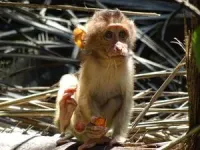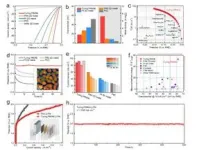(Press-News.org) Frequent visits to oil palm plantations are leading to a sharp increase in mortality rates among infant southern pig-tailed macaques (Macaca nemestrina) in the wild, according to a new study published in Current Biology. In addition to increased risk from predators and human encounters, exposure to harmful agricultural chemicals in this environment may negatively affect infant development.
In wild populations, infant survival is crucial for determining individual fitness and for maintaining viable populations in changing environments. For primates, agricultural areas adjacent to tropical forest habitat can be a mixed blessing: While crop plantations can provide easy access to food, they also come with increased exposure to various hazards, which is likely contributing to reduced infant survival in several wild primate species.
Exposure to palm plantations increases infant mortality
In a long-term collaboration between Universiti Sains Malaysia (USM), the German Centre for Integrative Biodiversity Research (iDiv), Leipzig University (UL), and the Max Planck Institute for Evolutionary Anthropology (MPI EVA), researchers set out to investigate potential links between frequent visits to oil palm plantations and the particularly high infant mortality they observed among wild southern pig-tailed macaques in Peninsular Malaysia. In a habituated study population in this region, 57% of all infants born between 2014 and 2023 died before the age of one – a rate that far exceeds mortality rates reported in other wild primate populations.
For almost ten years, the researchers followed two groups of macaques living in a mosaic of rainforest and oil palm plantations. They found that prolonged exposure to oil palm plantations during infancy tripled the likelihood of infant mortality. This key finding could be explained by increased encounters with predators and humans, and potential exposure to harmful chemicals such as pesticides in this environment.
“Some of these risks are relatively clear: infant macaques are more likely to fall prey to feral dogs that roam in the plantations in packs or to be captured by humans and sold illegally as pets,” explains Dr Nadine Ruppert from USM, who established and leads the field site. “But the potential long-term effects of the pesticides used to manage the monocultures on mammalian wildlife are much less obvious and very poorly understood.”
Pesticides may affect foetal development
The study also found increased infant mortality rates when mothers gave birth for the first time or when there was a long interval between two consecutives births, which contradicts studies that report increased mortality when the interbirth interval is shorter. The accumulation or uptake of pesticides in the mother’s body may play a key role: “The literature suggests that certain harmful substances used in agriculture can cross the placental barrier and be passed on to the unborn offspring. We also know that certain fat-soluble molecules can be passed on through breastmilk,” says lead author Dr Anna Holzner (iDiv, MPI EVA, UL and USM). “Accordingly, the longer the chemicals accumulate in the mother’s body, the more they could influence foetal development during pregnancy and also during lactation.”
The study highlights the urgent need to address anthropogenic threats to animals in agricultural landscapes. “We know that the use of pesticides in agriculture has led to drastic declines in insect populations, so chemical analysis is essential to understand the effects of pesticides on mammalian wildlife,” says Professor Dr Anja Widdig (UL, MPI EVA and iDiv), senior author and leading PI in this iDiv Flexpool project. “Our findings underscore the critical need to implement environmentally friendly cultivation practices that minimise the risks to wildlife populations and also to people living near plantations.”
END
Use of habitat for agricultural purposes puts primate infants at risk
Study reveals link between frequent plantation visits and infant mortality in wild southern pig-tailed macaques in Peninsular Malaysia
2024-01-08
ELSE PRESS RELEASES FROM THIS DATE:
Clinical research shows AI-enabled digital stethoscope can detect pregnancy-related heart disease
2024-01-08
JACKSONVILLE, Florida — New research from Mayo Clinic suggests that artificial intelligence (AI) could improve the diagnosis of peripartum cardiomyopathy, a potentially life-threatening and treatable condition that weakens the heart muscle of women during pregnancy or in the months after giving birth. Researchers used an AI-enabled digital stethoscope that captures electrocardiogram (ECG) data and heart sounds to identify twice as many cases of peripartum cardiomyopathy ...
Franco-German research funding in the field of biology
2024-01-08
The joint funding program of the French National Research Agency (ANR) and the German Research Foundation (DFG) promotes Franco-German cooperation in the natural sciences, the life sciences, and the engineering sciences. Through this program, Johannes Gutenberg University Mainz (JGU) will receive support for two distinctive projects in the field of biology.
The EVOMET project: Uncovering the evolution of metabolism in plants
Tomatoes, cucumbers, and potatoes taste different due to the accumulation ...
Fastest swimming insect could inspire uncrewed boat designs
2024-01-08
ITHACA, N.Y. – Whirligig beetles, the world’s fastest-swimming insect, achieve surprising speeds by employing a strategy shared by speedy marine mammals and waterfowl, according to a new Cornell University study that rewrites previous explanations of the physics involved.
The centimeter-long beetles can reach a peak acceleration of 100 meters per second and a top velocity of 100 body lengths per second (or one meter per second).
Not only do the results explain the whirligig’s Olympian speeds, but they also offer valuable insights for bio-inspired designers of near-surface water robots and uncrewed boats.
Until ...
Why do we sleep? Researchers propose an answer to this age-old question
2024-01-08
Sleep is a fundamental need, just like food or water. “You’ll die without it,” said Keith Hengen, an assistant professor of biology at Washington University in St. Louis. But what does sleep actually accomplish? For years, the best researchers could say is that sleep reduces sleepiness — hardly a satisfying explanation for a basic requirement of life.
But by melding concepts from the fields of physics and biology, Hengen and a team of Arts & Sciences researchers have constructed a theory that could explain both the meaning of sleep and the complexity of the brain. As reported in a new study published ...
Singh studying distributed computing models and algorithms for pervasive systems
2024-01-08
Gurdip Singh, Divisional Dean, School of Computing, received funding from the National Science Foundation for the project: "EAGER: Distributed Computing Models and Algorithms for Pervasive Systems."
The goal of this project is to extend the traditional graph-based distributed computing models and algorithms to develop a unified model to study cyber-physical systems. The unified models will capture interactions between the physical and cyber entities and the physical phenomena. This project also proposes to develop techniques to design distributed algorithms for fundamental problems ...
Narayanan developing treatments for alphaviruses
2024-01-08
Aarthi Narayanan, Professor, Biology, received funding for the project: "Further the development of Omaveloxolone and Bardoxolone methyl as broadly effective countermeasures against alphaviruses to Support the Battelle Accelerated Therapeutics for Combating Acute Viral Epidemics (BAT-CAVE) Program."
The principal purpose of this program is to conduct Research and Development into medical, pharmaceutical, and diagnostic technologies to enhance mission effectiveness of military personnel, collaborating ...
SwRI awarded $54 million contract to develop QuickSounder weather satellite
2024-01-08
SAN ANTONIO — January 8, 2024 —NASA and NOAA have selected Southwest Research Institute (SwRI) to develop QuickSounder, the first in a new generation of NOAA low-Earth orbit environmental satellites. Under the $54 million contract, SwRI will design and build the satellite and operate it for three years.
QuickSounder will kick off NOAA’s Near Earth Orbit Network (NEON) program. The Near Earth Orbit Network is a collaborative mission between NASA and NOAA. NASA will manage the development and launch of the satellites for NOAA, which will operate them and deliver data to users worldwide. NEON satellites ...
Novel tissue-derived brain organoids could revolutionize brain research
2024-01-08
Press release – Princess Máxima Center for pediatric oncology
EMBARGO: 8 JANUARY 2024 AT 11:00 AM ET (US)
Scientists have developed 3D mini-organs from human fetal brain tissue that self-organize in vitro. These lab-grown organoids open up a brand-new way of studying how the brain develops. They also offer a valuable means to study the development and treatment of diseases related to brain development, including brain tumors.
Scientists use different ways to model the biology of healthy tissue and disease in the lab. These include cell lines, laboratory animals and, since a few years, 3D mini-organs. ...
SARS-CoV-2 BA.2.86 is less resistant to vaccine, but may be a problem in the lung
2024-01-08
COLUMBUS, Ohio – New research shows that the recently emerged BA.2.86 omicron subvariant of the virus that causes COVID-19 can be neutralized by bivalent mRNA vaccine-induced antibodies in the blood, which explains why this variant did not cause a widespread surge as previously feared.
However, the study in cell cultures showed this SARS-CoV-2 variant can infect human cells that line the lower lung and engage in virus-host cell membrane fusion more efficiently, two features linked to severe disease symptoms.
The study is published today (Jan. 8, 2024) in the journal Cell.
The BA.2.86 variant of omicron is the ancestor of the currently dominating JN.1 and has about ...
Sibling death in childhood and early adulthood and risk of early-onset cardiovascular disease
2024-01-08
About The Study: In this study of more than 2 million individuals born in Denmark, sibling death in childhood and early adulthood was associated with increased risks of overall and most type-specific early-onset cardiovascular diseases, with the strength of associations varying by cause of death and age difference between sibling pairs. The findings highlight the need for extra attention and support to the bereaved siblings to reduce cardiovascular disease risk later in life.
Authors: Guoyou Qin, Ph.D., and Yongfu Yu, Ph.D., ...
LAST 30 PRESS RELEASES:
A new way to map how cells choose their fate
Numbers in our sights affect how we perceive space
SIMJ announces global collaborative book project in commemoration of its 75th anniversary
Air pollution exposure and birth weight
Obstructive sleep apnea risk and mental health conditions among older adults
How talking slows eye movements behind the wheel
The Ceramic Society of Japan’s Oxoate Ceramics Research Association launches new international book project
Heart-brain connection: international study reveals the role of the vagus nerve in keeping the heart young
Researchers identify Rb1 as a predictive biomarker for a new therapeutic strategy in some breast cancers
Survey reveals ethical gaps slowing AI adoption in pediatric surgery
Stimulant ADHD medications work differently than thought
AI overestimates how smart people are, according to HSE economists
HSE researchers create genome-wide map of quadruplexes
Scientists boost cell "powerhouses" to burn more calories
Automatic label checking: The missing step in making reliable medical AI
Low daily alcohol intake linked to 50% heightened mouth cancer risk in India
American Meteorological Society announces Rick Spinrad as 2026 President-Elect
Biomass-based carbon capture spotlighted in newly released global climate webinar recording
Illuminating invisible nano pollutants: advanced bioimaging tracks the full journey of emerging nanoscale contaminants in living systems
How does age affect recovery from spinal cord injury?
Novel AI tool offers prognosis for patients with head and neck cancer
Fathers’ microplastic exposure tied to their children’s metabolic problems
Research validates laboratory model for studying high-grade serous ovarian cancer
SIR 2026 delivers transformative breakthroughs in minimally invasive medicine to improve patient care
Stem Cell Reports most downloaded papers of 2025 highlight the breadth and impact of stem cell research
Oxford-led study estimates NHS spends around 3% of its primary and secondary care budget on the health impacts of heat and cold in England
A researcher’s long quest leads to a smart composite breakthrough
Urban wild bees act as “microbial sensors” of city health.
New study finds where you live affects recovery after a hip fracture
Forecasting the impact of fully automated vehicle adoption on US road traffic injuries
[Press-News.org] Use of habitat for agricultural purposes puts primate infants at riskStudy reveals link between frequent plantation visits and infant mortality in wild southern pig-tailed macaques in Peninsular Malaysia





